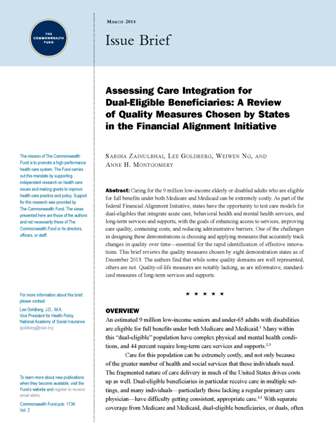By: Sabiha Zainulbhai, Lee Goldberg, Weiwen Ng, and Anne Montgomery
Published: March, 2014
March 24, 2014
SUMMARY: This brief examines methods by which a number of states are using innovative managed care models for their ‘dual eligible’ populations — low-income elderly or disabled adults enrolled in both Medicare and Medicaid — in order to control costs, reduce administrative barriers, and improve quality of care. States participating in this federal program created by the Affordable Care Act and launched in 2011, have a unique opportunity to test ways of integrating acute care, behavioral and mental health services, and long-term services and supports for these vulnerable beneficiaries.
One of the central challenges these states face in designing their demonstrations is choosing and applying measures that accurately track changes in quality over time. In reviewing the quality measures chosen by eight states, the brief finds that while some quality domains are well represented, others — such as standardized measures of long-term services and supports — are notably lacking.
Appropriate, standardized quality measures, are critical for officials at the state and federal level to be able to rapidly identify and change models of care that may be lacking in quality of care; such measures are also important for identifying effective innovations that ultimately could benefit the broader population of individuals with functional impairments and chronic care needs who are receiving services from a range of providers, from accountable care organizations and to traditional fee-for-service practices.
Production of this brief was funded by the Commonwealth Fund.
To download a PDF of the brief, visit the website of the Commonwealth Fund.

dddddddddddddddddd
